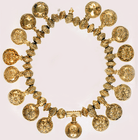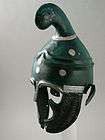Thracian treasure

The Odrysian kingdom in its maximum extent under Sitalces (431-424 BC).
[1]The Thracians (Bulgarian: Траки, Ancient Greek: Θρᾷκες, Latin: Thraci) were a group of Indo-European tribes inhabiting a large area in Central and Southeastern Europe, centred in modern Bulgaria.[2] They were bordered by the Scythians to the north, the Celts and the Illyrians to the west, the Greeks to the south, and the Black Sea to the east.
The Thracians either had skillful craftsmen themselves, or access to Greek craftsmen. They made beautifully ornate golden and silver objects such as various kinds of vessels, rhytons, facial masks, pectorals, jewelry, weapons, etc. These show strong, and increasing, influence from the neighbouring cultures, especially the Greeks. They used to bury rich hoards of precious objects both to hide them in times of enemy invasions and unrest as well as for ritual purposes. To date, more than 80 Thracian treasures have been excavated in Bulgaria which was the cradle of the Thracian civilization. Refer to the map which explicitly shows the territory of present-day Bulgaria.
Thracian treasures
| Ravnogor Thracian Treasure |
| Mogilanska Mogila Funeral Offerings |
| A thracian golden necklace found in Arabadjiiska Mogila |
| Golden treasure found at the Great Sveshtari Mound |
|
See also
References
- ↑ The Oxford Classical Dictionary by Simon Hornblower and Antony Spawforth, ISBN 0-19-860641-9, page 1514,"The kingdom of the Odrysae, the leading tribe of Thrace extented in present-day Bulgaria, Turkish Thrace (east of the Hebrus) and Greece between the Hebrus and Strymon except for the coastal strip with its Greek cities."
- ↑ Christopher Webber, Angus McBride (2001). The Thracians, 700 BC–AD 46. Osprey Publishing. ISBN 1-84176-329-2.
Further reading
External links












.jpg)





